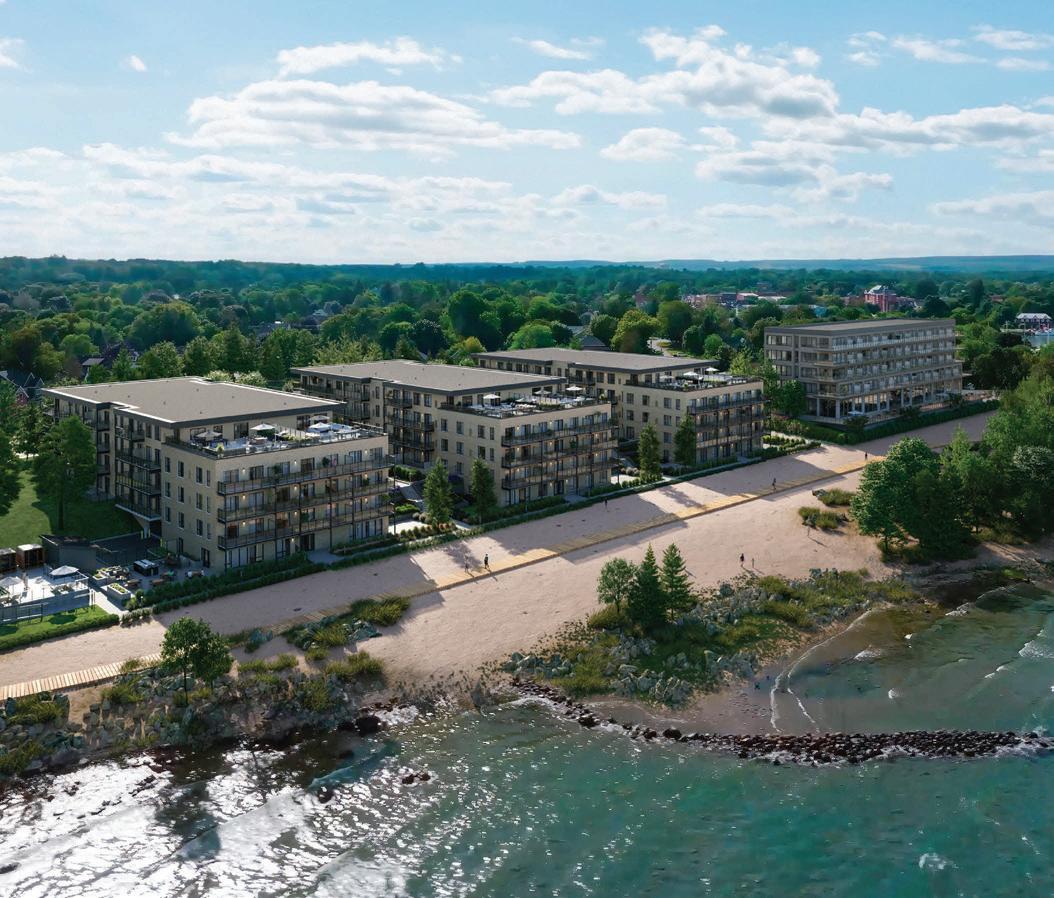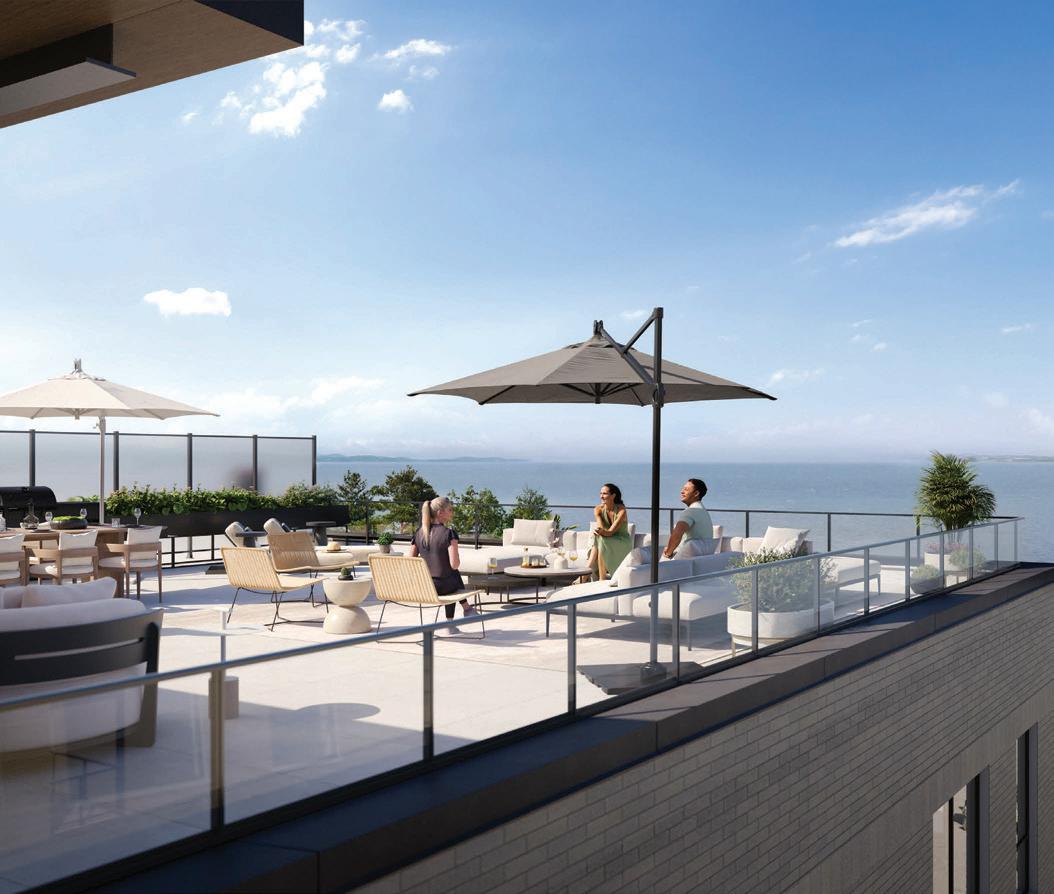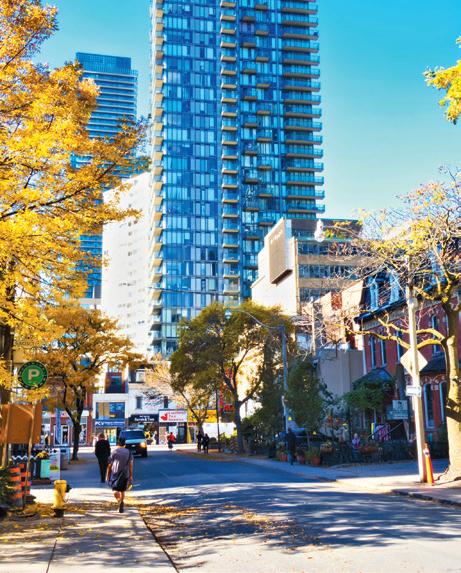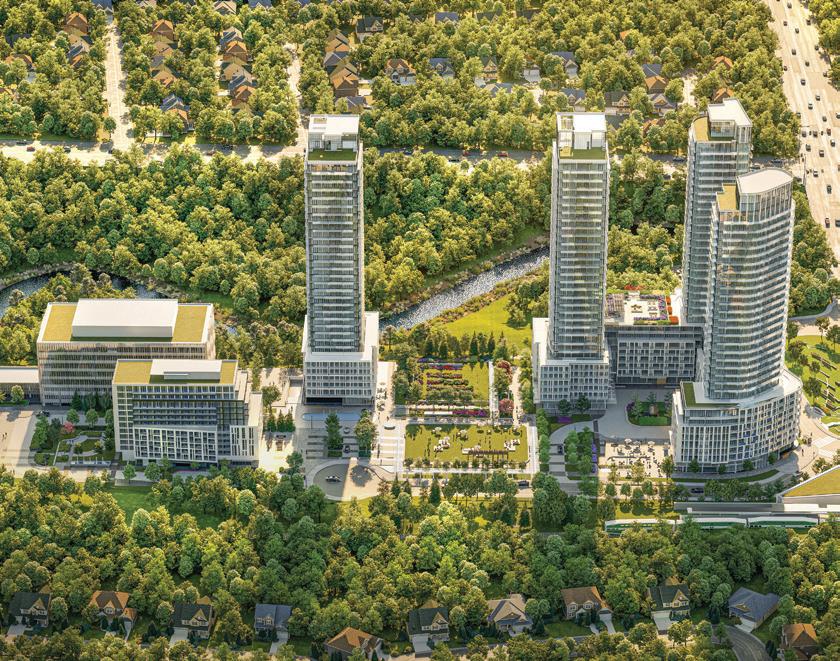









Aspen Shores welcomes all-season resort-style living to the Georgian Bay waterfront in Meaford. Discover a community of high-end condominiums backdropped by a stunning natural playground, brought to you by the visionaries at Skyline.


WAYNE KARL EDITOR-IN-CHIEF Condo Life Magazine
EMAIL: wayne.karl@nexthome.ca
TWITTER: @WayneKarl
When it comes to making that all important decision of buying a home, what matters most to you? A detached home on a nice lot with the proverbial white picket fence? Condo in a central location close to desired amenities? Proximity to transit, work and schools? Yes, those items still dot the wish lists of many prospective buyers, but a new report from ReMax Canada (see page 10) underlines just how shoppers’ desires are changing.
ReMax’s Next Neighbourhoods Report explores how high population growth and significant infrastructure investments, especially in transportation, are leading to improved neighbourhood quality across traditionally undervalued urban and suburban areas.
Focusing on the GTA and Vancouver, an Angus Reid survey commissioned by ReMax Canada found that 37 per cent of Canadians have made compromises to live closer to urban centres, including accepting a higher cost of housing. Almost half (41 per cent) of GTA residents compromised on price to land a location closer to an urban centre.
“New transportation links, often developed alongside housing, are transforming once overlooked and undervalued neighbourhoods into magnets for buyers seeking shorter commute times while achieving better affordability,” says Don Kottick, president of ReMax Canada.
“Livability is important to Canadians, and many buyers know what they’re willing to compromise on, in order to get more on their must-have list,” he adds. “Every market has something for everyone, but not all things. Compromise has always been part of the buying process, which includes managing expectations and setting realistic goals.”
Based on the criteria of affordability, quality of life and return on investment, two types of emerging neighbourhoods are highlighted in the report: Up-and-coming communities seeing advanced development, and regions that have traditionally been undervalued due to a lack of transportation access.
For the GTA, the report identifies the following hidden gem neighbourhoods: Aldershot South (Burlington), Clairlea-Birchmount (Toronto), Crown Point (Hamilton), Don Mills – Victoria Village (Toronto), Downtown Markham (Markham), Seaton (Pickering) and Wexford-Maryvale (Toronto).
Not all these areas have new home options, but what’s most important is what makes them appealing: Affordability, proximity to amenities such as restaurants and shopping, and public transit. In short, livability
Indeed, developers and new-home builders are fully aware of changing homebuyer demands, and are doing their part to cater to them as best they can.
As you research your new home destination, keep such criteria top of mind. Know what you want, what’s important to you, and what will make your new neighbourhood your own hidden gem.














An award-winning interior designer, Mariam Aboutaam is Director, Sales and Marketing, Interior Design at Kylemore, Markham, Ont., a builder known for master-planned communities and luxury homes. kylemoreliving.com.
Jesse Abrams is Co-Founder at Homewise, a mortgage advisory and brokerage firm based in Toronto. thinkhomewise.com
Elechia Barry-Sproule is President of the Toronto Regional Real Estate Board (TRREB) and Broker/Owner of Red Apple Real Estate Inc. She is committed to mentoring and supporting real estate professionals across the industry. trreb.ca.
Mike Collins-Williams, RPP, MCIP, is CEO West End Home Builders’ Association. westendhba.ca.
Debbie Cosic is CEO and founder of In2ition Realty. She has overseen the sale of more than $15 billion worth of real estate. With Debbie at its helm, In2ition has become one of the fastest-growing and most innovative new home and condo sales companies. in2ition.ca
Barbara Lawlor is CEO of Baker Real Estate Inc. A member of the Baker team since 1993, she oversees the marketing and sales of new home and condominium developments in the GTA, Vancouver, Calgary and Montreal, and internationally in Shanghai. baker-re.com
Linda Mazur is an award-winning, nationally publicized designer and Principal of Linda Mazur Design Group. With almost two decades of experience this in demand multi-disciplinary design firm is known for creating relaxed, stylish spaces and full-scale design builds within Toronto, the GTA and throughout Canada. lindamazurdesign.com @LindaMazurGroup
Ben Myers is the President of Bullpen Consulting, a boutique residential real estate advisory firm specializing in condominium and rental apartment market studies, forecasts and valuations for developers, lenders and land owners. Contact him at bullpenconsulting.ca and @benmyers29 on Twitter.
Dave Wilkes is president and CEO of the Building Industry and Land Development Association (BILD), the voice of the home building, land development and professional renovation industry in the GTA. For the latest industry news and new home data, follow BILD on Twitter at @bildgta or visit bildgta.ca
æ Sign up to receive digital editions & newsletters to your inbox!
Official Media Partners:

SENIOR VICE-PRESIDENT, SALES, NEXTHOME
Hope McLarnon 416.708.7987 hope.mclarnon@nexthome.ca
DIRECTOR OF SALES, ONTARIO, NEXTHOME Natalie Chin 416.881.4288 natalie.chin@nexthome.ca
SENIOR MEDIA CONSULTANTS
Amanda Bell 416.830.2911 amanda.bell@nexthome.ca
EDITORIAL DIRECTOR
Amanda Pereira
EDITOR-IN-CHIEF – GREATER TORONTO AREA
Wayne Karl wayne.karl@nexthome.ca
CONTRIBUTORS
Mariam Aboutaam, Jesse Abrams, Elechia Barry-Sproule, Mike Collins-Williams, Debbie Cosic, Barbara Lawlor, Linda Mazur, Ben Myers, Jayson Schwarz, Dave Wilkess
EXECUTIVE MEDIA CONSULTANTS
Jacky Hill, Michael Rosset
VICE-PRESIDENT, MARKETING – GTA
Leanne Speers
MANAGER CUSTOMER SALES/SERVICE
Marilyn Watling
SALES & MARKETING CO-ORDINATOR
Gary Chilvers
BUSINESS DEVELOPMENT MANAGER
Josh Rosset
DISTRIBUTION distributionteam@nexthome.ca
ACCOUNTING INQUIRIES accountingteam@nexthome.ca
DIRECTOR OF PRINT MEDIA Lauren Reid–Sachs
VICE-PRESIDENT, PRODUCTION – GTA Lisa Kelly
PRODUCTION MANAGER – GTA Yvonne Poon
GRAPHIC DESIGNER & PRE-PRESS COORDINATOR Hannah Yarkony
Published by nexthome.ca
Advertising Call 1.866.532.2588 ext. 1 for rates and information. Fax: 1.888.861.5038
Circulation Highly targeted, free distribution network aimed at real estate buyers using street level boxes, racking and Toronto Star in-home delivery.
Canadian subscriptions 1 year = 13 issues – $70 (inc. HST). Canada Post – Canadian Publications Mail Sales Product Agreement 40065416.
Copyright 2025 All rights reserved. All copyright and other intellectual property rights in the contents hereof are the property of NextHome, and not that of the individual client. The customer has purchased the right of reproduction in NextHome and does not have the right to reproduce the ad or photo in any other place or publication without the previous written consent of NextHome.
Editorial Submissions from interested parties will be considered. Please submit to the editor at editorial@nexthome.ca.
Terms and Indemnification Advertisers and contributors: NextHome is not responsible for typographical errors, mistakes, or misprints. By approving your content and/ or submitting content for circulation, advertisers and contributors agree to indemnify and hold harmless NextHome and its parent company from any claims, liabilities, losses, and expenses (including legal fees) arising out of or in connection with the content provided, including but not limited to any claims of copyright infringement, unauthorized reproduction, or inaccuracies in the content. Advertisers acknowledge that they have the necessary rights, permissions, and licenses to provide the content for circulation, and they bear full responsibility for the content’s accuracy, legality, and compliance with applicable laws upon approval. Contributors acknowledge NextHome reserves the right to omit and modify their submissions at the publisher’s discretion.
A new article by Altus Group, prepared for the Building Industry and Land Development Association (BILD) and the Ontario Home Builders’ Association (OHBA) demonstrates that without significant intervention to jump-start the housing sector, almost 50 per cent of residential construction sector jobs in the Greater Toronto Area (GTA) are at risk. The article further outlines that without action, by 2027, housing starts could fall by more than 60 per cent versus 2024 levels and construction investment could drop by more than $10 billion in the GTA. The article joins a growing body of research that points to the need to urgently cut the GST/HST on all new homes.
“The pipeline of future housing supply for the GTA is at risk, along with the livelihood of 41,000 workers in the region and billions of dollars of investments,” says Dave Wilkes, president and CEO of BILD. “Alongside this massive risk we now know, due to economic analysis undertaken on the cost for governments to eliminate the GST/HST on new homes, that the provincial and federal governments can mitigate against this by treating the new-home buyers of today more equitably.”
Altus Group’s paper, which can be found at bildgta.ca, analyzes the need to increase the urgency of addressing barriers (including excessive government taxation)

now, before these longer-term implications on the pipeline of construction, and ultimately on jobs and the broader economy, set in. It includes Analysis of the costs of extending the GST/HST exemption to all new owner-occupied housing, rather than the very narrow current federal government approach, for Ontario, as well as the federal level.
Prepared by the Missing Middle Initiative, the think tank estimated the total cost to extend GST/HST relief to all owner-occupied new home purchases to be $2 billion nationally and $900 million provincially.
“This one measure taken in tandem by the province and federal government can immediately lower housing costs, jump-start demand and protect against future supply shocks that spike prices,” adds Scott Andison, CEO of the Ontario Home Builders’ Association. “Parking the generational equality and affordability issues, it’s important to remember
that the government cost estimates are province-wide and nationwide, with housing starts in the GTA being approximately 20 to 25 per cent of the national average, and 40 to 45 per cent of the provincial average. That means for less than $1 billion, governments can protect at least 41,000 jobs, 23,000 annual starts and over $10 billion in investment – with all the spinoff associated with that. If you extrapolate this across the province the impact is even greater; if this were any other industrial sector, this wouldn’t even be a question.”
Housing is not a just-in-time product – the pipeline is long. Regulators observing lagging indicators of the sector’s health are looking in the rearview mirror and risk missing the opportunity to effect change to avoid a looming crisis. The time for action on the GST/HST exemption for all new housing, both provincially and federally, is now, BILD says.
The Building Industry and Land Development Association (BILD) recently recognized excellence in the design, construction, marketing and sales of new homes in the GTA at its 2025 BILD Awards Gala.
BILD presented 50 awards in the categories of architecture, design, marketing, people and sales, and in the prestigious project and builder categories. A group of 51 expert judges from across North America determined the winners from over 700 submitted entries.
“The BILD Awards is one of the largest and most prestigious awards programs of its kind in North America,” says Dave Wilkes, BILD president and CEO. “This year’s winners truly exemplify outstanding innovation and showcase the excellence of the building industry in the Greater Toronto Area.”
Howard Sokolowski, Founder and CEO of Metropia, received BILD’s Lifetime Achievement Award. It is the highest honour BILD can present to a member, recognizing those who have dedicated a lifetime to the association and the industry and demonstrated significant leadership and commitment to the greater good. Sokolowski has been at the forefront of Canada’s development industry for more than 30 years. One of the most trusted and influential industry leaders, he is renowned for building iconic communities that residents are proud to call home.
The Daniels Corporation was named Home Builder of the Year, Mid/ Highrise, while Great Gulf received the title of Home Builder of the Year, Lowrise. The Home Builder of the Year categories recognize builders who set the standard for the rest of the industry through their professionalism and dedication to excellence. A key component of the judging process is a customer satisfaction survey, which ensures that the end user’s experience is factored into the award criteria.

The winners of the top project and builder categories include:
• Green Builder of the Year, Lowrise – Great Gulf
• Green Builder of the Year, Mid/ Highrise – Tridel
• Angelo DelZotto Fearless Innovator Award – Assembly Corp.
• lgnat Kaneff Inspiration Award –Sam Condo, Weston Flooring Ltd.
• Riley Brethour Leadership Award –Adrian Rocca, Fitzrovia
• Stephen Dupuis CSR Award –Fitzrovia
• Best Overall Marketing Campaign – Equiton Developments – MAXIUM at 875 The Queensway – The Community, kg&a, Qoo Studio Inc., Patton Design Studio
• Best Advertising Campaign, Paid Media – Fitzrovia –Sloane by Fitzrovia – PUREBLINK, Qoo Studio Inc.
• Best Midrise Building Design –Equiton Developments – MAXIUM at 875 The Queensway – Patton Design Studio
• Best Highrise Building Design – Devron Developments – 101 Spadina – Gladstone Media, II BY IV DESIGN, RDS
• Best Community, Built – Fitzrovia – Elm-Ledbury – PUREBLINK, Qoo Studio Inc.
• Best Purpose-Built Rental – The Rose Corporation – The Bakerfield II – RAW Design, BGO
• Project of the Year, Lowrise –Arista Homes and Great Gulf – OAKPOINTE in Upper Joshua Creek – 1063 Guidelines, Hunt Design Associates, Qoo Studio Inc.
• Project of the Year, Mid/Highrise – North Drive Investments – One Roxborough West
• Best New Community, Planned/ Under Development – ARGO Development Corporation –Caledon Station – GSAI (Glen Schnarr & Associates Inc.)
In addition, Brixen Developments’ Exhale Residences, designed by Architecture Unfolded received the People’s Choice Award, which is voted by the public.
For a full list of BILD Awards winners, visit bildawards.com.
Greater Toronto and Greater Vancouver are experiencing population growth of more than three per cent annually, and significant infrastructure investments, especially in transportation, are leading to improved neighbourhood quality across traditionally undervalued urban and suburban areas, according to the Next Neighbourhoods Report from ReMax Canada.
“Canada’s urban population is growing at an astonishing pace,” says Don Kottick, president of ReMax Canada. “Municipalities need to work with their provincial and federal counterparts to increase transit and housing infrastructure –which is already happening in some pockets of the Greater Toronto and Greater Vancouver Areas. New transportation links, often developed alongside housing, are transforming once overlooked and undervalued neighbourhoods into magnets for buyers seeking shorter commute times while achieving better affordability. Expanding access strengthens connectivity in community and creates excellent potential for long-term liveability and value.”
Benjamin Tal, deputy chief economist at CIBC says, “population growth normally tracks at one per cent annually, but Canada has consistently seen upwards of 3.6-per-cent growth year-over-year. Governments, at all levels, are under-
projecting the population increases and consequently, could repeat past mistakes if they don’t pivot to reality. The Canadian government has realized they can have too much of a good thing, and need to have sustainable, measured growth.”
An Angus Reid survey commissioned by ReMax Canada found that 37 per cent of Canadians have made compromises to live closer to urban centres, including accepting a higher cost of housing.
Almost half (41 per cent) of GTA residents compromised on price to land a location closer to an urban centre.
“Livability is important to Canadians, and many buyers know what they’re willing to compromise on, in order to get more on their must-have list,” Kottick adds. “Every market has something for everyone, but not all things. Compromise has always been part of the buying process, which includes managing expectations and setting realistic goals.”
Based on the criteria of affordability, quality of life and a buyer’s return on investment, two types of emerging neighbourhoods surfaced: Up-andcoming communities seeing advanced development, and regions that have traditionally been undervalued due to a lack of transportation access and misconceptions.
The survey reports that 37 per cent of Canadians valued affordability as a top factor in choosing their neighbourhoods, followed closely by proximity to amenities such as restaurants, shopping and grocery stores (36 per cent) and convenient access to public transit (31 per cent). Canadians want to spend more time in their neighbourhoods shopping at local stores (58 per cent), dining out (52 per cent) and socializing with friends, family and neighbours (43 per cent), underpinning the impact a chosen community has on day-today liveability.

As governments at all levels invest in infrastructure and community revitalization, most Canadians say they feel these policies bring added benefits to their communities, with more businesses (88 per cent) and restaurants (87 per cent) having the greatest impact. New infrastructure, especially transit development, ranks lower at 41 per cent, but arguably has the biggest impact on the emergence of a “next neighbourhood.”
As population increases, governments have begun investing in transit infrastructure – often a precursor to new businesses flocking to communities and facilitating growth. “Communities often experience transit development before and alongside new residential housing,” says Kottick. “In Ontario, we’ve seen rapid housing developments labeled Transit-Oriented Communities hugging the new Ontario Line actively under construction.”
Tal adds, “Canada needs to look at alternative housing models including factory-made construction to drastically increase housing starts to address the ongoing supply issue. Expanding transit and other infrastructure is also just as important, as it adds affordability and connectivity to traditionally lessaccessible communities.”
• Clairlea-Birchmount (Toronto)
• Wexford-Maryvale (Toronto)
• Crown Point (Hamilton)
• Aldershot South (Burlington)
• Downtown Markham (Markham)
• Seaton (Pickering)
• Don Mills – Victoria Village (Toronto)








Buying a new home is one of life’s biggest decisions, particularly in the ever-changing Greater Toronto Area housing market. As a residential housing analyst and host of the Toronto Under Construction podcast,
I have crunched the numbers forward and backward, and filled in the gaps in the data by engaging some of the region’s most prominent developers, lenders and brokers. I recently hosted three of Toronto’s most prominent architects in an insightful discussion about what the future holds for the GTA new condominium market. On Episode 86 of the Toronto Under Construction podcast, I spoke with Clifford Korman of Kirkor Architects, Richard Witt of Quadrangle
Architects, and Gabriel Fain of Gabriel Fain Architects about their visions for the city’s future.
Architects often lead the conversation about city-building, and this trio is no exception. Fain passionately argues that Toronto must “remove barriers to build, build and build more housing.” His proposal for a bold, vertically-integrated community at Victoria Park and Danforth, featuring 578 rental units, a Montessori school and a public

“
” Future highrise condo developments must prioritize sustainable designs, communityoriented planning and adaptable living spaces to thrive.
park, underscores his belief in dense, urban, transit-oriented development. However, he highlighted significant hurdles, including outdated zoning laws, political resistance to height and density, and building codes that lag behind Toronto’s ambitions.
In light of changing market dynamics, Korman shared valuable insights into how developers are adapting to softening condo demand.
According to Clifford, developers holding excess density are exploring new ways to integrate communitycentric features, such as schools, daycares, community centres and seniors’ housing. This shift reflects a broader change from maximizing short-term profit to creating neighbourhoods that sustainably meet residents’ long-term needs.
Witt expanded the conversation by addressing the emerging concept of the “Polycentric City,” which describes communities functioning as interconnected hubs of workplaces, retail spaces and housing. While he acknowledges the compelling potential of these “skyscraper villages,” he cautions prospective buyers that creating vibrant, sustainable communities requires more than building towers – it involves strategic planning, integrated
transit infrastructure, and community engagement over decades.
Clifford’s optimism about transforming traditionally cardependent areas, such as the Golden Mile into thriving, pedestrian-friendly communities highlights a broader trend towards rethinking urban connectivity and mobility.
A notable market trend discussed was the shift from condos to purpose-built rental housing, driven by evolving consumer demand and lower pre-construction investor interest. Developers are increasingly pivoting towards rental developments that offer more two- and threebedroom units, improved amenities and long-term durability. Witt emphasized that this trend not only supports better architectural practices, but also creates stable, enduring assets. Rental buildings must attract and retain tenants over time, leading to enhanced livability and more thoughtful design.
Sustainability also emerged as a key topic during our conversation. Architects increasingly face the challenge of balancing environmental efficiency with comfort and usability. Witt addressed a critical concern about reducing features such as balconies and extensive glazing to improve energy efficiency. His insights remind prospective homebuyers that achieving sustainability should not compromise residents’ quality of life or their connection to outdoor spaces.
Fain introduced an intriguing perspective about material choices, specifically advocating for masonry over glass, referencing renowned architect Robert A.M. Stern. According to Fain, masonry offers a timeless, warm and textured aesthetic that enhances Toronto’s streetscapes, standing in stark contrast to the often impersonal nature of glass towers. Embracing richer materials can give Toronto’s condos lasting appeal and an enduring sense of place.
For prospective homebuyers navigating the GTA market, while the condo boom may be over, there
will be more rental apartments built, but we’ll likely see more small-scale buildings with unique architectural features. Future highrise condo developments must prioritize sustainable designs, communityoriented planning and adaptable living spaces to thrive. The decisions made by architects today will shape Toronto’s residential landscape, directly influencing where and how we choose to live tomorrow.
If you’re an investor or an enduser concerned about resale value and you’re considering buying a new condominium, you would be wise to take these talking points into consideration. What is the exterior design of the building? How are the floorplans laid out? What amenities are included in the building, and are they built for the future or meant to look glitzy in a sales brochure? Is the neighbourhood walkable and community focused? Is the local community changing for the better? With the fear of missing out no longer driving the market and the frenzied buying environment behind us, prospective buyers such as yourself now have the opportunity to slow down, compare options thoughtfully, conduct thorough research and choose a home that fits both your current budget and your long-term financial goals.
Surround yourself with an experienced team, do your own research, and buy what you can afford. Good luck.
Ben Myers is the President of Bullpen Consulting, a boutique residential real estate advisory firm specializing in condominium and rental apartment market studies, forecasts and valuations for developers, lenders and land owners. Contact him at bullpenconsulting.ca and @benmyers29 on Twitter.
+MORE CONTENT ONLINE nexthome.ca


Want to help improve the economy? Buy a new home or condo. Consumer confidence has a lot to do with making an economy thrive. The more optimistic consumers are about their financial situations, the more spending we see happening.
In turn, this drives economic growth and encourages investment and job creation. In fact, consumer spending is a significant driver of our economy by contributing to our GDP (gross national product) and employment. According to the Canadian Construction Association, the construction industry employs more than 1.6 million workers in Canada and contributes approximately $162 billion to our economy each year. This accounts for 7.5 per cent of Canada’s GDP.
“
” First, pricing has come down out of necessity, especially when you consider the generous incentives developers are offering nowadays.

The construction industry also involves numerous related services, including sales and marketing brokerages, heavy and civil engineering, trade contracting, property management firms, ad agencies, public relations firms, cabinet companies, roofing contractors and numerous construction suppliers, representing thousands of jobs.
Real estate is also a foundation of wealth creation for homeowners and has been for decades because of the appreciation of properties. Canadian investment dollars also make for substantial rental income for investors. Currently, forces have conspired to make this an excellent time to buy a new home or condominium.
First, pricing has come down out of necessity, especially when you consider the generous incentives
developers are offering nowadays. Ask about low and extendedpayment deposits, up to five years free maintenance fees, cashback on closing, moving costs paid and zero closing costs.
For example, at The Dawes by Marlin Spring, Condos in the Danforth, purchasers of threebedroom suites receive a payment from the developer after closing of $4,000 per month for two years; twobedroom $3,000 per month for two years, and one-bedroom and onebedroom plus den $2,700 a month for two years. This amounts to up to $96,000 in total savings and helps pay the carrying costs each month for the duration. In addition, there are reduced development charges and levies, and owners have the right to lease during interim occupancy.
Mortgage interest rates are still historically low, and this has a massive
“
” One of the best things about buying a new home or condominium is that you can find something that fits your lifestyle and timing.
effect on how much in monthly payments buyers can make. And remember the new government help for affordability (elimination of GST for first-time buyers up to $1 million; lower GST for up to $1.5 million). In addition, there is talk of expanding this benefit to all new home buyers, not just first-time purchasers.
One of the best things about buying a new home or condominium is that you can find something that fits your lifestyle and timing. Move in now or in a couple of years – and be the very first to live in your beautiful space. Warranty coverage is another benefit of buying new.
When our housing market booms, there are ripple effects that contribute to a healthy economy. If you are thinking of buying your first home or you are an experienced homebuyer, consider taking a good look around right now for incredible deals.
Become an economic driver for your financial future and that of Canada’s. But new, and buy now.
Barbara Lawlor is CEO of Baker Real Estate Inc. A member of the Baker team since 1993, she oversees the marketing and sales of new home and condominium developments in the GTA, Vancouver, Calgary and Montreal, and internationally in Shanghai. baker-re.com

JESSE ABRAMS

As homebuyers across Canada wait and wonder, a quiet shift is underway. After years of bidding wars, recordlow listings and rising interest rates, the 2025 housing market looks a little different, particularly in major centres such as the GTA, Vancouver, Calgary and Edmonton. Across these markets, inventory is climbing, sellers
are adjusting and interest rates have begun trending downward. For many, this begs the question: Is now finally a good time to buy? Let’s break it down.
According to recent data from the Canadian Real Estate Association, housing inventory in key urban markets has grown steadily over the past six months. New listings are up, and active inventory levels, especially in Alberta and Ontario, are giving buyers more breathing room than they’ve had in years.
“ ” If you’re a buyer who was priced out by rate increases in 2023 or 2024, now might be the time to revisit your numbers.

Why the shift? A mix of factors:
• More homeowners are listing ahead of mortgage renewals
• Pre-construction completions are hitting the market
• Buyers are more cautious, giving sellers less leverage This has created what some would call a “balanced market,” and in certain neighbourhoods, even a buyers’ market as prices have dropped in some areas quite significantly from the height of the market in early 2022. Translation: More negotiating power, less pressure to waive conditions and actual time to think before you sign.
After two years of aggressive interest rate hikes, we’ve finally started to see some movement in the other direction.
In June 2024, the Bank of Canada made its first rate cut since 2020, a symbolic shift that could continue if inflation remains under control. While fixed mortgage rates had already
started to edge lower in anticipation, this move may signal more favourable borrowing conditions ahead.
If you’re a buyer who was priced out by rate increases in 2023 or 2024, now might be the time to revisit your numbers. With mortgage approvals becoming more flexible and options more competitive, monthly affordability is improving – even if prices haven’t dropped dramatically.
Contrary to some expectations, we haven’t seen a crash in home prices. Instead, while some markets have seen prices drop 10 to 15 per cent from the peak in 2022, many markets have seen flat or slightly softened prices, especially in suburban areas or higher-density housing types such as condos and townhomes.
This stability can actually be good news. It suggests a healthier, more sustainable market – one that isn’t driven by frenzied speculation or fear
of missing out. For buyers, that means a clearer picture of what they’re walking into. No guessing games. No wild swings.
There’s no universal answer, but here’s a good framework:
• You have a stable income and a down payment in place
• You plan to stay in your home for at least three to five years
• You’re buying a property that meets your long-term needs
• You’re getting a mortgage rate that aligns with your monthly comfort zone
If that’s you, the current market could offer more selection, less competition and improving borrowing conditions.
At Homewise, we work with first-time buyers and seasoned homeowners every day, helping them compare mortgage options from more than 30 lenders. What we’re seeing right now is slightly renewed optimism, especially among those who were sidelined last year due to rates or limited inventory. That doesn’t mean it’s a race. But it does mean opportunity is creeping back in.
Markets don’t always send a clear signal. But growing inventory plus easing rates equals a compelling combination. For buyers who are prepared, thoughtful and financially ready, this could be a window worth considering. And if you’re not quite ready to jump in, that’s okay, too. The market is shifting toward balance. Which means, for once, time may be on your side.
Jesse Abrams is Co-Founder at Homewise, a mortgage advisory and brokerage firm. thinkhomewise.com
+MORE CONTENT ONLINE nexthome.ca

AND BUYER CONFIDENCE REPRESENTS WINDOW OF OPPORTUNITY
DEBBIE COSIC

Another rate hold from the Bank of Canada on June 4 underscores the delicate balancing act between taming inflation and sustaining economic momentum. For the housing market, this continued pause places further strain on affordability, especially for first-time buyers and variable-rate mortgage
holders who were holding out hope for relief this summer.
“ ” Canada is in the midst of a housing and affordability crisis that is not only persistent, but increasingly urgent.
While some were anticipating that a series of rate cuts would unlock pent-up demand and reignite activity, the most recent announcement suggests a slower-than-expected rebound. We can expect real estate decisions – from home purchases to development launches – to remain measured and cautious through the summer months.
However, I have to express a degree of personal disappointment. Canada is in the midst of a housing and affordability crisis that is not only persistent, but increasingly

urgent. We’re seeing more families sidelined from homeownership, more developers hesitating to bring projects to market, and more young people wondering if they’ll ever build a future in a system that feels out of reach.
“ ” At a time when Canadians are feeling squeezed from all angles, the need for a more responsive, coordinated approach has never been greater.
While I respect the Bank’s cautious stance in battling inflation, the current pace of monetary policy adjustment feels misaligned with the severity of the housing challenge on the ground. At a time when Canadians are feeling squeezed from all angles, the need
“
” Despite the shortterm pause, there is still reason to feel cautiously optimistic.
for a more responsive, coordinated approach has never been greater. What we need now is not only responsible rate policy, but real, multi-level government intervention that supports housing supply, affordability and access. That means:
• Enhanced support for first-time homebuyers (especially when it comes to down payments)
• Re-evaluation of restrictive lending criteria that lock out qualified buyers
• Acceleration of development approvals and smarter zoning policy
• Access to flexible financing tools that empower families and investors alike
Despite the short-term pause, there is still reason to feel cautiously optimistic.
The next Bank of Canada announcement on July 30 may land at just the right time to bring momentum back into the market and set the stage for a strong, active fall. But the wise buyer or investor won’t wait for a headline to act. With attractive deals already circulating –particularly in pre-construction and value markets, this summer presents an important window of opportunity. In real estate, timing is everything and smart decisions start before the headlines change.
Debbie Cosic is CEO and founder of In2ition Realty. She has overseen the sale of more than $15 billion worth of real estate. With Debbie at its helm, In2ition has become one of the fastest-growing and most innovative new home and condo sales companies. in2ition.ca
+MORE CONTENT ONLINE nexthome.ca

CAN PROTECT YOU FROM TITLE FRAUD
MIKE COLLINS-WILLIAMS

Buying a home is one of life’s most exciting milestones. Amid the joy of choosing paint colours and booking movers, there’s one important protection homeowners often overlook: Title insurance. For a onetime cost of about $250 to $500, title insurance can shield you from legal and financial nightmares, including the growing threat of title fraud. Title insurance provides peace of mind by protecting homeowners

“ ” Fraudsters are becoming increasingly sophisticated, using forged documents and fake identification to gain access to a property’s legal title.
from issues that may not surface during the property closing process. These issues can include errors in public records, undisclosed liens and – most alarmingly – title fraud. In cases of title fraud, criminals steal your identity and use it to illegally sell or refinance your property without your knowledge. Homeowners typically don’t find out until they try to sell their home or receive overdue mortgage payment notices.
Those most vulnerable to title fraud include homeowners who have paid off their mortgages and landlords who rent out their properties. However, anyone who owns a home can become a target. Fraudsters are becoming increasingly sophisticated, using forged documents and fake identification to gain access to a property’s legal title. Once that happens, they can remortgage or even sell the home, leaving the rightful owner in a costly and emotionally distressing situation.
Title insurance is a one-time premium paid at the time of closing, though it can also be purchased later as a homeowner policy. While postclosing policies may have certain limitations, they can still provide crucial protection, particularly in private transactions or estate sales.
While title insurance cannot prevent fraud, it can help mitigate the damage. In the event of title theft, it can cover legal expenses required to restore your ownership rights and defend against fraudulent claims. Some policies even include coverage for legal services, but it’s important to read the fine print and ask your real estate lawyer for clarification on what your policy includes.
Although title insurance is optional in Ontario, it’s a smart investment
considering the risks. For less than $500, you can protect what is likely your most valuable asset. In a housing market where title issues and fraud are not completely uncommon, this small one-time expense offers substantial long-term security. Before finalizing your home purchase, or even if you’ve already closed, speak with your lawyer about title insurance. It may be one of the most important steps you take to safeguard your home – and your peace of mind.
“ ” In a housing market where title issues and fraud are not completely uncommon, this small one-time expense offers substantial longterm security.
Mike Collins-Williams, RPP, MCIP, is CEO West End Home Builders’ Association. westendhba.ca.
ELECHIA BARRY-SPROULE

Have you been waiting for the right time to buy a home? You’re not alone. Over the past year, many would-be buyers have watched the market closely, waiting for conditions to shift in their favour.
That shift began in May.
Across the Greater Toronto Area (GTA), more homes came on the market, prices eased compared to last year, and borrowing costs improved. For buyers who were ready – and working with a knowledgeable realtor – that meant more choice, stronger negotiating power and the ability to move forward with confidence.
According to TRREB’s latest Market Watch report, GTA realtors recorded 6,244 home sales in May 2025, a 13.3-per-cent decline from May 2024. At the same time, new listings were up by 14 per cent year over year. This signals a shift toward a more balanced market – which gives buyers more leverage.
Housing affordability has improved. The average selling price in May was $1.12 million – down four per cent compared to May of last year. The MLS Home Price Index Composite benchmark also declined by 4.5 per cent year-over-year.
Combined with lower borrowing costs than this time last year, these changes are helping more buyers find a way into
the market. For many, the numbers now work where they didn’t before.
However, real estate is never onesize-fits-all. While some areas are heating up, others still offer room for negotiation. That’s where local expertise becomes invaluable. A realtor who understands your target neighbourhood and property type can help you navigate today’s evolving market and make informed decisions.
Sales and average prices both ticked up from April to May on a seasonally adjusted basis. This was the second month in a row that sales improved, suggesting that buyers are starting to re-engage.
Still, some households remain cautious, especially in light of broader economic uncertainty and interest rate trends. As TRREB CEO John DiMichele notes, “With the federal government’s housing commitments reiterated in the Throne Speech, we now need concrete actions that will restore housing affordability across the GTA and the rest of Canada.”
We’re watching closely for further interest rate cuts, faster housing approvals, and relief from high taxes and fees – all of which are critical to unlocking supply and keeping homeownership within reach.
Whether you’re buying your first home or looking to smart-size, now is the time to explore your options. Increased inventory, improved affordability and less competition may make this the opportunity you’ve been waiting for.

A professional realtor can guide you through the numbers, help you assess your choices and ensure you’re positioned for success.
For more housing insights and the latest Market Watch reports, visit trreb.ca.
Elechia Barry-Sproule is President of the Toronto Regional Real Estate Board (TRREB) and Broker/Owner of Red Apple Real Estate Inc. She is committed to mentoring and supporting real estate professionals across the industry. trreb.ca.

INSPIRATION | decor

by LINDA MAZUR
With the start of each renovation project, it’s easy to get caught up in the fun details of colours, furnishings and finishes. The aesthetics of your home are obviously of great importance and should reflect your personality, as well as how you live. We constantly explore design magazines and Pinterest for inspiration and the latest trends to give us a direction for our next renovation. Not wanting to compromise, we aim to create a magazine-worthy look in our homes,
while being true to our budgets. When designing a space, many of us look to fabrics and colours as our inspiration… why not look down and get inspired by your floors instead? Flooring is one important aspect of your home and should not be overlooked. Whether you consciously notice or not, flooring can make a large impact to the overall aesthetic of your space. When it comes to the more permanent finishes in your home, such as flooring, it is important to find materials, styles and colours
that suit your functional needs, while complementing your style and budget.
For several years, we have witnessed a huge expansion in flooring products. With advancements in quality, durability and applications, as well as colours and finishes, there seems to now be endless choices to suit all budget levels. We are all familiar with traditional hardwood and engineered flooring. Traditional hardwood, due primarily to the installation method, is not a


customary option for condo living. Engineered wood, on the other, hand can be a great option for condo flooring. Much like natural hardwood, engineered wood floors add wonderful warmth and elegance to a space, but with the added benefit of being lighter in weight for condos and have varying installation methods that are just not suitable for solid hardwood. Engineered also has the added benefit of reduced shrinkage and expansion that is more customary with solid hardwood, offering greater stability with less warping and gaps.
Trends have been moving more towards softer and naturally warmer organic tones for flooring. Rich walnuts, lighter natural white oaks and a resurgence of rich, deeply saturated espresso browns to name a few. While the lighter tones are a perfect neutral foundation that integrates well with anything from a more minimalist, modern style to traditional, these warmer yet richer tones can create a sense of luxury, drama and sophistication.
With technological advancements, “faux” flooring options look more and more like the real thing, and can be a less costly option for your home. They are not only highly durable with waterproof options, but beautifully

texturized to appear natural looking, while being low maintenance.
Laminate, which has been around for a while, is a hard surface flooring that is manufactured using material such as medium or high-density fibreboard to form the core.
Luxury vinyl, on the other hand, is a soft surface flooring product that is flexible. It comes in a variety of installation options, providing not only a great look, but comfort as well. Luxury vinyl is available in an abundance of fantastic options that have the look of wood, stone or other natural material.
Vinyl composite core is a flooring option that combines the best features of laminate and luxury vinyl. Boards are rigid planks that click together like laminate, but are constructed from a water-resistant vinyl composite material that gives them the flexibility of vinyl flooring that can be installed anywhere – even bathrooms and laundry rooms. By using longer, wider boards for your flooring, regardless of the product type, you are not only creating a more contemporary feel that draws inspiration from European design, but it can also give the illusion of making your space appear larger – especially if you continue the same floor

throughout your entire space. This is especially alluring in smaller spaces such as condos, so don’t be afraid to think big in your flooring selection. As for “wood” floors, we should not eliminate parquet as an option. Parquet flooring is pretty much a mosaic of wood pieces combined to create a pattern. The most common patterns for parquet are basketweave, diagonal and herringbone. Parquet flooring was trendy in the 1970s and 1980s, however, we have seen a resurgence in recent years. The modern version of parquet is a classic, luxurious “Euro” look that is durable and affordable.
Flooring often does not get the attention it deserves. In fact, given all the options available, it could be the basis of design for your space. Beautifully worn, 100-year-old floors tell a story of their previous life while still inspiring a vibe of eclecticism and current design trends. Herringbone floors feel elegant, sophisticated and well-curated. Warm toned, wideplank floors can create an inviting and cosy vibe, while the lighter blonde tones can convey a more contemporary feel. Whatever style, texture and colour of flooring you choose, let it inspire the look and feel of your home.
Linda Mazur is an award-winning, nationally publicized designer and Principal of Linda Mazur Design Group. With almost two decades of experience this in demand multidisciplinary design firm is known for creating relaxed, stylish spaces and full-scale design builds within Toronto, the GTA and throughout Canada. lindamazurdesign.com @LindaMazurGroup

Wherever you choose to buy your new home, one essential step in creating a beautiful interior is deciding how to treat your windows. If you’ve purchased from Kylemore, you’ll enjoy an abundance of large, light-filled windows designed to make every room feel brighter and more open.
I’m often asked for advice on adding blinds and drapes, and it’s an important finishing detail I prioritize when designing our model homes. Window treatments aren’t
by MARIAM ABOUTAAM
just functional; they’re a powerful design element that shapes how a space feels.
The right window coverings bring warmth, personality and a sense of completion to a room, just like the perfect piece of furniture or a stunning piece of artwork. Drapes, sheers and shades do more than cover glass; they help express your style.
Today’s options for window treatments are nearly endless, with lots of innovative and exciting choices. From side panels and flowing drapery to sleek shutters, classic blinds and shades, you can create any mood you desire. There are equally as many varieties of materials from rich fabrics to natural textures, such as wood, bamboo and rattan, as well as metal and high-tech plastics. Your budget and

personal style will help determine the direction you take.
Tip: In an open-concept floorplan, for example, where the kitchen, breakfast and family or great room are adjoining, choose a palette that is consistent through this space but need not be all the same type of window covering.
When styling our model homes, I often select neutral shades for window treatments. This creates a versatile foundation, letting bold furniture or vibrant accessories take centre stage.
If you love bold patterns or rich colour, try layering. For example, a subtle blind inside the window frame paired with patterned fixed drapery panels on either side. This will give you the impact you’re looking for without locking you into one look for the long-term.
Tip: If your room already has strong patterns – think wallpaper or statement tile – a solid curtain or blind in a coordinating neutral tone helps calm the visual noise.
Privacy is key, especially in bedrooms, bathrooms and perhaps also in rooms facing streets or close neighbouring homes. Silhouette shades are a stylish solution, offering both soft light and obscuring views into the room when you want it.
Tip: For bedrooms, consider blackout fabrics or room-darkening blinds; these can make a real difference in sleep quality and overall comfort.


Modern window treatments are all about blending form and function. I’ve been using many distinctive styles to suit the interior design in model homes, from soft fabric Roman shades and textured sheers to tailored tab-top curtains.
Pinch-pleated or ripple-fold drapery works beautifully in transitional homes, while wooden blinds, used alone or with fabric panels, bring warmth and character to a more contemporary themed home.
Want a more luxurious touch? Try layering curtains: Pair a sheer or linen for softness and privacy, topped with velvet or silk drapes in a bold pattern for extra richness.
Tip: Hang curtain rods at ceiling height and let drapes fall to the floor; this draws the eye upward and makes the room feel taller. For everyday functionality, motorized tracks are worth the upgrade.
Bathrooms deserve beautiful window treatments too. Light-diffusing shades, bold drapes or simple linen panels can balance privacy with style. Bring each bathroom to life with a brightly painted chair, decorative side table or lush green plant, simple additions that turn a bathroom into a personal retreat.
Whatever mood you want to create – serene, sophisticated or vibrant – your window treatments help bring that vision to life, completing the appearance with a practical and functional element.
In my next column, we’ll explore another critical design element: Flooring. From timeless hardwood to stylish vinyl and my new favourite –porcelain tile – you’ll discover how to ground your home’s interior design with beauty and durability.
An award-winning in-house designer, Mariam Aboutaam is Director, Sales and Marketing, Interior Design at Kylemore, Markham, Ont., a builder known for masterplanned communities and luxury homes. kylemoreliving.com.
The
1. Bristol place 199 Main St, North, Brampton
2. Duo condos Malta ave & Steeles Ave
3. Mayfield Collection 2256 Mayfield Road. Mayfieldcollection.ca
4. Curio Condos 801 The Queensway marlinspring.com
5. Humberwood Heights 50 Humberwood Blvd. tributecommunities.com
6. Arcadia District Bloor & Kipling arcadiadistrict.com
7. Kül Condos 875 The Queensway kulcondos.com
8. Panda Markham 8200 Warden Ave. lifetimedevelopments.com
9. Gallery Towers at Downtown Markahm 162 Enterprise Blvd. downtownmarkham.ca
10. Highmount 4077 Hwy. 7 highmountbykingdom.com
MISSISSAUGA
11. Birch at Lakeview Village Lakeshore & Dixie Rd. branthaven.com
12. Artform Condos 86 Dundas St. E. emblemdevcorp.com
13. Exhale Condominiums Lakeshore Rd. East & Dixie Rd. exhalelakeshore.ca
14. Westport 28 Ann Street westportcondos.ca
15. Central Park Sheppard Ave. East & Leslie St. amexon.com
16. Yonge City Square 4050 Yonge St. yongecitysquare.com
PICKERING
17. Vupoint Kingston Rd. & Liverpool Rd. tributecommunities.com
OSHAWA
18. U.C. Tower 2425 Simcoe St N,Oshawa tributecommunities.com
TORONTO
19. Lawrence Hill Urban Towns Don Mills & Lawrence lawrencehillurbantowns. com
20. 489 Wellington St. W. 489 Wellington St. W. lifetimedevelopments.com
21. 500 Dupont St. 500 Dupont St. lifetimedevelopments.com
22. Artistry Condos 292 Dundas St. W. tributeartistrycondos.ca
23. Panda Condos Yonge & Dundas. lifetimedevelopments.com
24. 36 Eglinton Ave. W. 36 Eglinton Ave. W. lifetimedevelopments.com
25. Linx Condominiums Danforth & Main tributecommunicties.com
26. Y&S Condos 2161 Yonge St. tributecommunities.com
27. 50 at Wellesley Station
50 Wellesley St. East pureplaza.com
28. No. 1 Yorkville 1 Yorkville Ave. pureplaza.com
29. Theatre District Residences Adelaide & Widmer pureplaza.com
30. Bijou on Bloor 2450 Bloor St. West pureplaza.com
31. The Briar on Avenue 368 Briar Hill Ave. pureplaza.com
32. One Seventy Spadina & Queen St. West pureplaza.com
33. King West & Charlotte King St. West & Charlotte pureplaza.com
34. Forest Hill Private Residences
2 Forest Hill Rd. foresthillresidences.com
35. Oscar Residences 500 Dupont St. W. at Bathurst oscarresidences.com
36. Kingside Residences Kingston Rd. & Danforth altreedevelopments.com
37. Allure Condominiums 250 King St. East emblemdevcorp.com
38. XO Condos King & Dufferin lifetimedevelopments.com
39. 225 Jarvis Street Condos Dundas St. East & Jarvis amexon.com
40. 101 Spadina Spadina & Adelaide 101spadina.com
41. The Residences of Central Park Sheppard Ave. East & Leslie centralparktoronto.com
42. The Dawes at Main Street Danforth & Main St. thedawes.com
43. Birchaus Birchcliffe Village on Kingston Road birchausresidences.com
44. Knotting Hill 4000 Eglington Ave. W knottinghillcondominiums. com
45. Park Avenue Place 1 & 2
Jane St. & Rutherford Rd. solmar.ca
The latest properties in the Southwestern Ontario Area to keep your
1. Affinity Condos Plains Rd. E. & Filmandale Rd. rosehavenhomes.com
2. Millcroft Towns Appleby Line & Taywood Dr. branthavenmillcroft.com
3. North Shore North Shore Blvd. & Plains Rd. nationalhomes.com
FORT ERIE
4. Discoverie Condos Signature Communities discoveriecondos.ca
HAMILTON
5. 1 Jarvis 1 Jarvis 1jarvis.com
6. The Design District 41 Wilson Street emblemdevcorp.com
7. Corktown 225 John Street South corktown.condos
NIAGARA
8. Lusso Urban Towns Martindale Rd. & Grapeview Dr. lucchettahomes.com
9. The Greenwich Condos at Oakvillage Trafalgar Rd. & Dundas branthaven.com
10. Synergy McCraney St. E. & Sixth Line branthaven.com
11. Upper West Side at Oakvillage 351 Dundas St. E. upperwestsidecondos2.ca
12. Greenwich Condos at Oakvilage Trafalgar Rd. & Dundas St. branthaven.com
13. Villages of Oakpark Dundas & Trafalgar ballantryhomes.com
STONEY CREEK
14. Casa Di Torre 980 Queenston Rd. branthaven.com
15. On The Ridge Lormont Blvd. & Chaumont Drive liveontheridge.ca

































































The federal government recently tabled its proposed GST/HST reduction measures on new homes. Unfortunately, like many federal housing policies, the proposal to exempt first-time new homebuyers from the GST for homes of less than $1 million and provide a declining exemption to homes for $1.5 million does not recognize the realities of the Greater Toronto Area (GTA) and will have little impact on housing supply and affordability in this region.
The fact that the government is proposing even this limited measure is a tacit acknowledgement that the tax, along with the other myriad of government fees and taxes heaped onto new homes, is one of the barriers to affordability. This is compounded by the failure to keep structural mechanisms, such as the GST/HST new housing rebate program current to market property values. However, the current federal proposal is lacking in many ways.
First, is the comparatively small number of new-home buyers who are first-time buyers in the GTA. While the number may be higher in other jurisdictions, in the GTA, estimates of first-time buyers as buyers of new homes are between five and 10 per cent. Recognizing that resale homes do not attach GST/ HST means that the total number of people who would benefit in
the GTA ranges between 1,500 and 3,000 in an average year, and a paltry 500 to 1,000 people based on 2024 annual sales. In a metropolitan area that represents 20 per cent of the Canadian population – and is one of the fastest growing regions in North American – this is a symbolic drop in the bucket.
Second, the dollar figures used are geographically biased. While $1 million will buy a very well-heeled detached single-family home in almost every other part of Canada, except the GTA and the lower mainland of BC, the average price for a new condominium in the GTA in April was $1.01 million and $1.53 million for a single-family home (including townhomes, semis and detached). So, while a purchaser in Ottawa can buy a fully detached single-family home in the mid-$800,000s and pay no GST, a comparable product in the GTA would cost in excess of $1.5 million and attract nearly $70,000 in GST. And before you say, “but salaries in the GTA are higher,” the average annual household income in Ottawa is $125,700 and in the GTHA it is $129,000. By selecting dollar thresholds that are not reflective of high-property value jurisdictions, the federal government is basically ignoring the regions where the need is the greatest.
Last, when the GST was introduced, it had a corresponding rebate program that applied to 95 per cent of purchasers so that it would “not pose a barrier to the affordability of new housing in Canada.” Now, with properly values effectively excluding
anyone in the GTA from a GST rebate, and such a narrow federal proposal, effectively 90 to 95 per cent of homes are subject to the GST and receive zero rebate. This means less incentive to move up in new housing as families grow and expand, or down in new housing as seniors age and look to downsize, limiting mobility within existing housing stock and impeding the addition of appropriately sized new supply.
As the federal government continues to benefit by collecting billions in excess GST/HST on new homes, the time has come for the federal government’s actions to match its rhetoric. A viable solution for Canada must include the GTA and Lower Mainland BC and that means making any GST relief apply to all new homes (including substantially renovated homes – such as renewing existing housing stock by replacing greater than 90 per cent of the building) and having dollar thresholds that meet the needs of the region.
Dave Wilkes is President and CEO of the Building Industry and Land Development Association (BILD), the voice of the homebuilding, land development and professional renovation industry in the GTA. For the latest industry news and new home data, follow BILD on Twitter, @bildgta or visit bildgta.ca.




